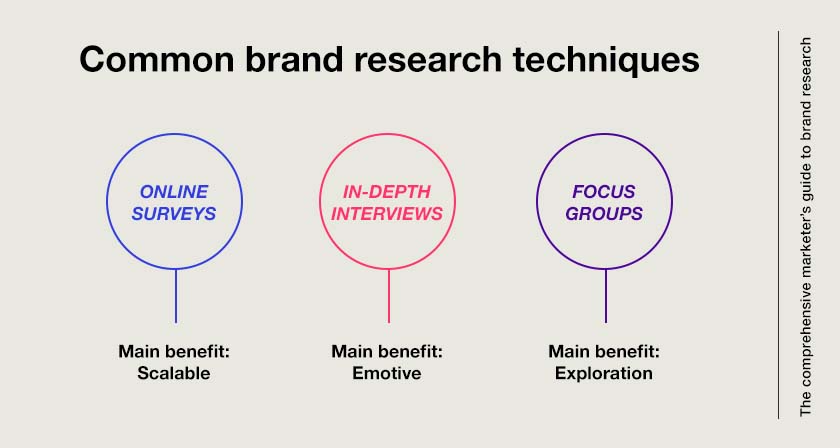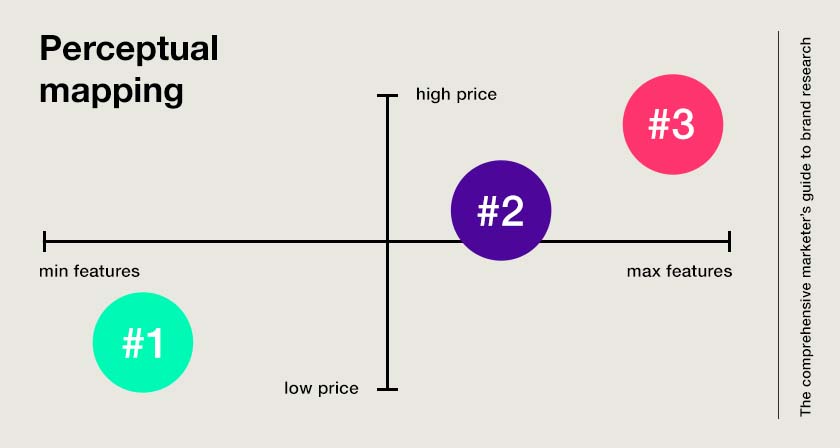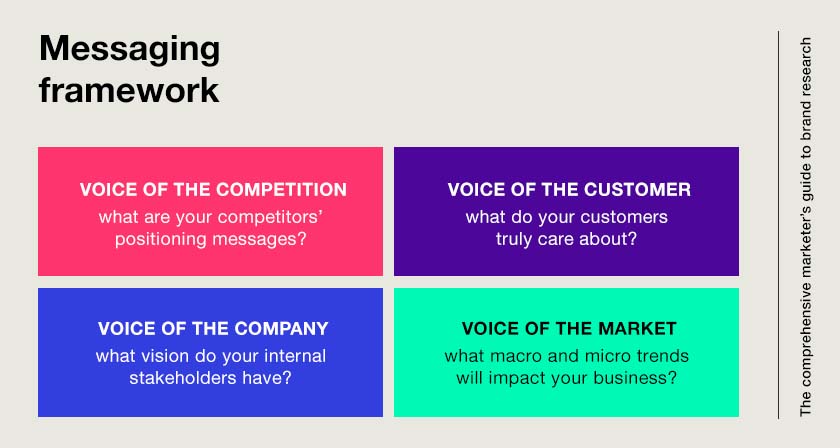
The comprehensive marketer’s guide to brand research
What you need to know about brand research, and how it can help you stand out from the competition.
In crowded markets, gaining a competitive advantage is key as it’s the only way you can sustainably attract new customers and maintain brand loyalty.
Yet, many B2B companies struggle to truly differentiate their brand. This is mainly due to a phenomenon called ‘strategic herding’, where past recipes for success are taken for granted and become ‘the way things are done’ in the sector.
How can marketers get their organisations out of the ‘sea of sameness’ and come up with unique messaging?
The answer lies in brand research. This article will help you understand the most fundamental components of brand research—including goals, techniques, and ways you can use brand research to develop (or redevelop) your brand strategy.
What is brand research?
Brand research is an organised effort to collect data about your brand and how stakeholders perceive it, so you can understand its overall health. This includes measuring your brand reputation, visibility and equity.
By analysing and acting on the insights gained from this process, you can create—and manage—strong, memorable, and likable brands.
What is the ultimate goal of brand research?
When it comes to brand management, information is everything.
In an ideal world, marketers would be able to easily understand people’s thoughts, feelings, beliefs, and attitudes toward different brands. But since they only exist in buyers’ minds, it’s our responsibility to find out and ask.
That’s where brand research comes in. Its true goal is to help you understand your brand’s overall role in the marketplace (with the help of formal data collection and analysis). When performed correctly, it can help you uncover your most valuable differentiators (at least, in the eyes of prospective buyers, customers, and clients). You’ll be able to use them to formulate a powerful and accurate messaging strategy, which can then help you gain a competitive advantage.
When is the right time to conduct brand research?
All companies undergo significant business-defining changes at some point or another. When this happens, you must adjust your organisation’s brand strategy so that it’s in line with these changes. This should almost always be informed by some form of brand research.
New startup companies that haven’t yet launched a product typically conduct brand research alongside market and persona research (since it’s typically more efficient and cost effective that way).
Mature organisations tend to pursue it whenever one of the following happens: when growth has stalled, when their brand identity becomes dated, or when internal stakeholders no longer know how to describe the firm’s positioning.
Still, other events can also trigger a need for brand research—regardless of company age. These include:
- Mergers or acquisitions
- Changes to your brand architecture (e.g. brand extensions)
- Emerging competitive threats
- When your target audience has completely changed

What are the most common brand research techniques?
As with any kind of research, there are multiple ways to collect the data you need to develop (or redevelop) your company’s brand. The more diverse your sources are, the more robust your methodology will be.
Online surveys
Online surveys can be extremely valuable for brand research, regardless of what brand development stage you’re currently at. It’s popular among businesses because they’re scalable (meaning you can distribute them to a large number of people without much effort).
Brand research surveys often exist in the form of Net Promoter Score (NPS) surveys, where you ask respondents how likely they’ll recommend your brand to a colleague on a scale of zero to ten.
You can indeed design your own survey, but you do have to make sure of two things. First, since most online surveys have a quantitative purpose, you have to follow a certain protocol when developing them. This means setting clear hypotheses about your brand first and then proving or disproving them with data. Second, you have to make sure that your survey doesn’t contain any leading or confusing questions (which can impact the validity and reliability of your results). Always run a pilot test before launching!
In-depth interviews
An in-depth interview is a research method that relies on asking relevant participants questions using a pre-defined framework (meaning you already decided on the topics and subtopics you’ll explore). They can either be done online or face-to-face.
There are two useful types of in-depth interviews: structured and semi-structured. Unlike the former, the latter doesn’t involve following a strict sequence and allows room for additional questions. As these interviews are conducted on a one-to-one basis, you can easily take note of participants’ paralanguage (e.g. facial expressions and nuances in their voices). This is especially valuable if you’re trying to understand how people currently feel about your brand.
Some key questions you could ask include:
- What was your first reaction to our brand?
- How would you describe your latest interaction with our brand?
- If we came to you and said we made a bunch of changes, what would you hope to hear? What would you hope not to hear?
To get started, you’ll need to use accurate audio recording and transcription software such as Descript and Google Speech-to-Text (otherwise, you’ll have to spend days manually transcribing your interviews). And if you plan on coding and analysing the transcripts yourself, qualitative data analysis software platforms like NVivo will come in handy.
Focus groups
Compared to surveys, focus groups are a much less scalable method of brand research—so getting large amounts of standardised data shouldn’t be the goal here.
However, the benefit of focus groups is the sheer breadth and richness of qualitative information you can collect, which is ideal when you have a real need for exploratory brand research. For instance, you might be developing a new brand and entering an unfamiliar market at the same time.
There are a few things to keep in mind when hosting a focus group. First, you should select a moderator who is not only knowledgable about the industry but is also flexible enough to manage group dynamics. This is to make sure you get the most out of each participant; some people are more shy than others!
Second, you should carefully consider your sampling strategy. Focus groups should be pretty homogenous; participants should share a few common characteristics (like their occupation). That’s to make sure everyone is comfortable enough to speak openly and freely. And in terms of the ideal number of focus group sessions, there’s no hard and fast rule. One is rarely sufficient, but anything more than eight is also likely to be inappropriate. This is because your research would’ve probably reached ‘saturation’, meaning you’re unlikely to discover anything new or meaningful by hosting additional sessions.
How can companies use brand research to their advantage?
Brand research can help you develop three main internal documents, each of which are key to a successful brand strategy.
List of brand differentiators
Having a simple list of brand differentiators can align your internal stakeholders’ understanding of what exactly sets your organisation apart from competitors. They can also help you craft an effective positioning statement. If you already have a list, brand research can help you confirm whether your external stakeholders (i.e. your customers) actually perceive your claims to be true or not. What you uncover during this process may be surprising!
If your objective is to discover your organisation’s points of differentiation, try asking questions like:
- What word comes to mind when you hear our brand name?
- Why do you choose our brand over others?
- What does our brand offer that competitors don’t offer?
Keep in mind that a differentiator is only a differentiator if it meets all of the following criteria:
- It must be true
- It must be important to your target persona.
- It must be provable (otherwise, this can lead to ‘doubtful’ brand positioning).
Most B2B brands differentiate by specialising in an industry, offering a unique technology or process, having a specific geographical focus, or honing in on a particular target audience. But you can also find brands that really emphasise their unique business models and exceptional customer service.

Perceptual maps
Perceptual mapping is a technique marketers use to better understand where brands in a relevant category ‘fit’ in the minds of target buyers and customers. Understanding this is important because the way prospects position your brand has an effect on their long-term purchasing decisions.
Generally, perceptual maps are represented as two-dimensional plot graphs with four quadrants and two axes. The axes should be labeled according to what is most relevant for your customers. For instance, a tech brand may choose to create a map based on ‘features’ and ‘price’ (since they’re two attributes that have a large influence on their purchasing decisions).
However, if you believe that there are more than two important determinant brand attributes, you can indeed create more sophisticated variations (or multiple perceptual maps).
Questions that can help you accurately draw a perceptual map include:
- Who are our brand’s true competitors?
- What are your key priorities?
- Rank this brand in order of preference from a list of competitor brands based on X, Y Z.
It’s worth noting that if you find your brand to be in the middle of every perceptual map you draw, there’s likely a problem. That means the people you collected data from (whether it’s customers or otherwise) don’t have a clear understanding of what makes you stand out. This is a phenomenon known as ‘under-positioning’, which often leads to inconsistent sales volumes. To overcome this, you may need to audit your brand marketing activities and find ways to communicate your unique selling point (USP) more clearly.

Messaging framework
A messaging framework is a strategic document that identifies your tone of voice, your primary personas and what sort of messaging is appropriate for each. This will help your organisation standardise your communications to all of your customers.
To successfully develop this framework, you’ll need to draw on four types of insights:
- Voice of the competition: what are your competitors’ positioning messages?
- Voice of the customer: what do your customers truly care about?
- Voice of the company: what vision do your internal stakeholders have?
- Voice of the market: what macro and micro trends will impact your business?
Messaging frameworks tend to include a strapline, an elevator pitch, key value propositions, tone of voice guidelines, and separate messaging sections for different personas. Within each section, you’ll need to identify a core need for that particular persona, outline key challenges and objections, and include how your brand solves those problems (with proof points).
To help you accomplish these goals, you may ask your stakeholders (external and internal) questions like:
- What do you value most?
- What are your biggest challenges?
- How do you think our firm delivers on our promises?
Conclusion
Brand research is one of the most fundamental components of brand management. Without it, decisions about your organisation’s messaging remain based on guesswork and personal assumptions. By selecting the right research methods and techniques for your company, you can collect the data you need to develop your brand strategy and boost your competitive advantage with differentiated messaging.
Read the latest positioning trends and insights.
Tap into our brand and product positioning, storytelling, and creative expertise to inspire your next strategic move.

